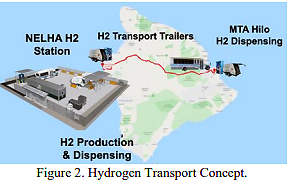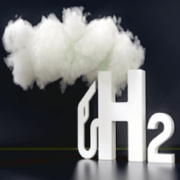Hydrogen Dreams; Hawaii Energy Error
Hawaii Island report; UPDATE
Mayor Roth’s Hydrogen Dream
Hydrogen (H2) has been on Hawaii’s energy radar for over 10 years now when in the University at Manoa released its first report to the state entitled; “Hawaii Renewable Hydrogen Program: Policy Evaluation & Recommendations.” The report was commissioned to determine gaps and barriers within the existing state energy guidelines designed to guide effectively changes and lay the groundwork for legislation to fill policy gaps and reduce barriers to Hydrogen production in the state.
Legislation in the state did follow in the form of amendments to he state’s Renewable Energy Portfolio guidelines, better known as RPS. At the time hydrogen was included within the guidelines as an energy substitute for fossil fuels, it was intended to be one of several energy options for the state to achieve its energy independence from imported fossil fuels by 2045, as determined by the 100% renewable energy goal (RPS).
Under the leadership of President Biden, 10 years later, national policy and federal funding caught up Hawaii’s hydrogen dreams in the form of advancing R&D hydrogen test sites and create the economic foundation for hydrogen as a replacement for fossil fuels, aka the “hydrogen economy”.
Fast forward to the hydrogen present –
The long history of the heavily funded Hu Honua Bioenergy (biomass power plant) proposal requires increasing electric rates and increasing greenhouse gas emissions in exchange for the right to chop down and burning Hawaii Island forests (the lungs and carbon sink of planet Earth) on the path regulatory approval for generating electricity on behalf of Hawaii Island’s utility and customer grid, owned and operated by Hawaiian Electric (HELCO).
The project proposal dates back to 2008, and pre-dates today’s popular and local hydrogen dreams and schemes. The failed-to-launch Hu Honua power plant may be the only proposed power project in state history to go before the Hawaii Supreme Court no less than four sequential appeals and legal rebuts.
After Hu Honua`s recent legal defeat before Hawaii’s Supreme Court many assumed the ill-conceived energy project was dead, that is until Hawaii County’s Mayor Roth’s administration recently came to the rescue plan, first by quietly approving in after-the-fact fashion County permits this past spring. This action triggered Life of the Land to file an information request with the County. The County’s response noted that Hu Honua would not say what their plans were, and that Hu Honua had not instigated the request to approve the permits. If Hu Honua didn’t request the permit process exception, why did the County intervene on their behalf? Anyone who has had the challenging experience of working through the County’s building permitting process processes will testify such an outcome is totally unprecedented, so again, why the special treatment?
This unprecedented County action occurred without public notice or explanation. The County’s unprecedented action was in response to Hu Honua which had recently built several structures without acquiring the necessary building permits and approvals from the County. County’s self-initiated process-approval actions was a step with intended or unintended consequences by advancing the ill-fated power plant prospects. It was an action that runs counter not only to County protocol and longstanding community opposition to the plant, but also runs counter to state Supreme Court and PUC decisions.
The Hawai’i County Planning Department must submit proposed revisions to the General Plan every ten years.
The current 180-page proposal presented on September 19, 2023, also includes another gift to Hu Honua and its stakeholders. The Draft Land Use Pattern Allocation Guide (LUPAG) shows that the land area zoned as Heavy Industrial at Hu Honua would more than double in size. Presumably, this would enable a hydrogen conversion station to be built alongside the currently inactive Hu Honua power plant and facility.
Earlier this year, Hu Honua submitted a letter from Hawai’i County Mayor Mitch Roth to the Public Utilities Commission. Hu Honua asserted that the Mayor was backing them. Mayor Roth subsequently stated he was not endorsing Hu Honua and that he didn’t remember the letter. The Mayor asserted that he was pushing hydrogen, and in theory, one could chemically, thermally, and or use electricity to convert trees into hydrogen gas. Thus, Hu Honua permits needed to be processed.
Earlier, the Hawai’i State Energy Office submitted a bid to become one of the seven proposed national hydrogen hubs as part of President Biden`s initiatives. The state effort recently failed. However, sources told Beyondkona that Hawaii County is continuing to push ahead with its own efforts to build a hydrogen future, and so far without any substantive public or County Council review.
Why push Hu Honua towards becoming a hydrogen production facility? Who needs it? Who benefits? And who pays for it? In the background to these publically unanswered questions has been been the Roth administration roadshow for hydrogen. This past summer, Mayor Roth and his R&D and Environmental departments heads have been engaged in a countywide road show / talk story promoting their ideas and vision of a so-called hydrogen economy beginning in Hawaii County. In a July energy-centric webinar promoting hydrogen and featuring the Mayor, when asked, Mayor Roth told the audience, “…Hawaii County is not in the energy business.” Based on his Administration’s recent actions, the opposite could not be more true.
With Hu Honua principals facing repeated regulatory, legal and community barriers to their designs of producing and selling electricity to HELCO, if the plant instead became a hydrogen production and possible fueling station for County H2-fueled vehicles, it would an unprofitable business case and far from economically sustainable. The development of hydrogen-based transportation systems requires infrastructure to produce, compress, store, and deliver the hydrogen; a means to dispense the fuel; and vehicles to use the hydrogen. Those basic fundamentals require market demand, which in turn requires market infrastructure, and plenty of capital to underwrite such a risky public venture, again, and the business case completely supporting and fully justifying Hawaii’s market demand for a hydrogen economy, especially when the electrification of ground transportation in Hawaii already well on its way.
The problem with H2
Perhaps Mayor Roth’s hydrogen push should be applauded, at minimum, as the County’s highest elected official, such an energy policy now being promoted with County resources and by extension, funded with taxpayers dollars, should first be subject to public review. Such a review should first examine the costs and benefits. So far, Roth and his team have failed to make the case for Hydrogen development on Hawaii Island, and for that matter, anywhere else.

Natural Energy Laboratory Hawaiʻi Authority (NELHA), is the County’s experimental platform for so-called clean energy business propositions, nearly all of which do NOT use and are engaged in the production of clean energy, here was the perfect candidate to fulfill someone’s hydrogen dream.

The question to how NEHAL would produce hydrogen remains unclear. One of several key drawbacks to H2 production is that it requires a lot of energy, and where that energy comes from no only matters, it also effects to the levels of energy inefficiency associated with producing hydrogen in the place, which in short, requires more energy to produce H2 than it returns as a fuel. In the NELHA proposal, this remains a fully unqualified question and answer. The same H2 fueling program requires that H2 is produced adn/or stored at NEHAL in Kona and trucked to Hilo to ensure fueling is accessible on both sides of the Big Island.
Based on statements by Roth administration representatives there has been talk of Hu Honua as a potential production source for Hydrogen on Hawaii Island. This could solve the County’s theoretical problem of trucking H2 fuel from Kona to Hilo.
Absent local market demand for hydrogen, and talk of the County converting its vehicle fleet over to H2 as a fuel as a justification for the H2 push, the economics and practicality of such a proposal is little more than a hydrogen dream, and a potential nightmare for taxpayers. The big H2 picture for the County’s proponents is the need to develop a market for hydrogen outside of the island, and a vision that Hawaii’s mid-pacific location is an ideal location to set-up a H2 filling station and/or export facility infrastructure for the gas on Hawaii island, Oahu andc ustomers outside of Hawaii for that matter. Failure to image is not he problem, rather it is a solid business case which is missing in this entire discussion. Likely a factor in the Feds decision to turn down the state’s application for some of that free Federal money in pursuit of H2 dreams..
Beyond the economic questions, there are the climate and environmental issues associated with producing hydrogen and managing an efficient hydrogen (H2) hub, and doing it in an environmentally and climate friendly way. Certainly, burning trees at Hu Honua (and the forever supply of Hawaiian trees and deforestation needed to fuel Hu Honua is another entire unresolved issue) in order to produce hydrogen gas. None of this makes sense or is practical by any honest measurement, and someone need to sit down with the Mayor and talk facts, not wishful aspirations.
Any hydrogen economy needs a hydrogen infrastructure to support it raises the immediate questions of building the needed infrastructure to store and distribute hydrogen safely and efficiently – and who pays for it. Do we do this as matter of County policy ahead of addressing real world infrastructure questions facing Hawaii Island, and the state in total – where is the required due diligence, ahead of political cheerleading?
The County and other parts of the state are facing growing problems that include addressing aging and increasingly ineffective water and waste management systems, cesspool conversions, and road – bridge repairs, and transforming outdated permitting and regulatory roadblocks to a truly enabling clean energy conversion process. If nothing else, the growing climate crisis mandates needed regulatory and process reforms, certainly if Hawaii is to ready itself for the ever increasing climate challenges now directly impacting the state.
Our recommendation to Mayor Roth, stop chasing energy unicorns. Focus on and enable public and private sector initiatives now underway which are slowing advancing the state’s transition to a 21st century clean energy economy, from the electrification of transportation to clean energy security and resilience. These are quantifiable and achievable benefits of a clean energy economy for Hawaii, and the County. It can be as simple as plugging-into the Sun and Hawaii’s tradewinds. No burning required.
Breaking News: Hu Honua’s back from the dead
Hu Houna stakeholders and their agents are in the process of writing another chapter in an unending story, which so far is poorly written. One of BeyondKona’s consulting energy experts, Henry Curtis, predicts the most likely future for Hu Honua is that it will submit a bid in the latest HELCO Request for Proposals, whereby Hu Honua would produce electricity (by burning local trees) to produce electricity to HELCO, and possible generate hydrogen on the side for the only potential customer; Hawaii County.
Another of BeyondKona’s consulting energy experts, Steve Holmes, see an outcome this way; Hu Honua will likely go the Stage 3 solicitation route. I presume they will use the “firm “ power path as way of avoiding an outstanding barrier to being a grid supplier of electricity — by conventional measurements Hu Honua can’t compete on a cost per kWh with solar plus storage.
Hu Honua could also sell a limited amount of hydrogen needed by a few County buses and that certainly doesn’t help the economics either. Hu Honua seems unable to bring their costs down and all the phony baloney carbon neutral stuff already decided by the Hawaii Supreme Court against HuHonua’s previously arguments before the court doesn’t go away. The NPDES (water quality) permit issue remains another unresolved barrier of entry for Hu Honua in spite of the bizarre scheme to add locally drilled deep cold groundwater to the plant’s discharge water.
BeyondKona see this latest round in justifying Hu Honua’s role in Hawaii Island energy future as little more than lipstick on a pig.
The aforementioned contains some reference content (with permission) from Henry Curtis’ Oct. 16th Ililani Media blog. Henry is also a contributing editor to BeyondKona. http://www.ililani.media/2023/10/hawaii-county-is-advocating-for-hu.html
The rich history of the Hu Honua saga can also be found in earlier BeyondKona coverage, examples include:
- https://www.beyondkona.com/hawaii-supreme-court-rules-against-hu-honua-5-0-whats-next/
- https://www.beyondkona.com/the-hu-honua-saga-continues/
- https://www.beyondkona.com/an-open-letter-to-hawaiis-puc/
- https://www.beyondkona.com/hu-honua-meltdown/
- https://www.beyondkona.com/hu-honua-2019-burn-trees-for-power-update/




Good article Bill. Beyond Roth’s fan boy enthusiasm, don’t forget the ‘unanimous’ vote for a resolution in the Council. Where was their due diligence?
Also, you failed to mention the 750 lb. gorilla that may be greasing the skids at every turn – namely, former public works director Warren Lee. He may appear less gross than the typical 800 pounders out there, but he’s been flogging away with his old boy network and the endless coffers of uber investor, Ms. Jennifer Johnson of Pacific Heights, San Francisco, USA!